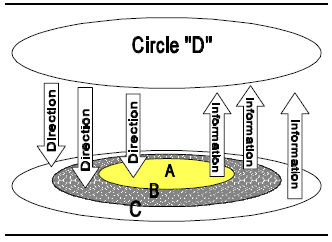Decision
making should include all affected interest groups.
— Long’s Peak Working Group
(America’s Waters: A New Era of Sustainability, 1992)
The
first step in the Drought Preparedness Study (DPS) method is to assemble a planning team. Managing
Water for Drought expands this step into problem identification, but
here we will focus on the concepts behind team building.
There
is a natural, physical integration of water problems in a river
basin; the
challenge is to assemble a problem solving team that can work
with a
corresponding wholeness. The
first step in the DPS method was designed to overcome two common
shortcomings in water management: the
separation between stakeholders and the problem solving process,
and the
subdivision of natural resources management by limited agency
missions. Each problem will affect a group of stakeholders and be
managed by
one or more agencies.
The
underlying concept behind building a team is an approach called “Circles
of Influence.”

Figure 1: Conceptualization of
Circles of Influence
Individuals involved in a DPS can be described as belonging to
one of three circles, A
through C (Figure 1). Each
successive circle from A through C has broader representation
but less
personal involvement. If one were to develop a composite of the
four
DPS’s of the National Drought Study, Circle A managed the study
and did
most of the actual work. Circle A included the Corps study
leader, as well
as 2 to 4 others from outside the Corps. They spoke several
times a week, managed contracts, arranged meetings of larger groups,
built models, did research, and wrote letters,
papers, and reports.
Circle B includes Circle A as well as one representative from each major
stakeholder group (such as industrial users). The ideal circle B participant will be active in professional
or issues-oriented organizations. They would also be trusted and respected
by others whose interests he or she represents. The activity of the
participant outside the DPS is important because it takes advantage of
existing channels of communication. And if the Circle B participant is
trusted and respected, stakeholders outside Circle B will be more willing to
support the study despite their decision to be less directly involved in
the study. Circle B members will probably need to meet a few times a year. They
may review and revise draft papers from Circle A.
Circle C includes a representative from each major stakeholder group, each
management agency and each advocacy group. For the DPSs, Circle C
participants numbered from 20 to 60 and met twice a year in fairly formal
workshop settings.
Regional decision makers (agency heads and elected officials) constitute a fourth
circle, “D.” During the DPS, they were involved formally at the
beginning and end and were kept informed during the study
through their study representatives.
Table 1 illustrates the examples of the types of people that might work in each
of the circles of influence.
Table 1: The Types of People that Might Work in each of the Circles of Influence
Circle
Categories |
A |
B - includes A,
adds: |
C - includes B,
adds: |
D: Decision Makers |
| Agencies |
Corps, City and State Water Department Staff |
State Fisheries staff |
Other Corps, State offices, city water departments |
Mayor, Governor, Chief of Engineers or authorized designate |
| Users |
Hydropower industry staffer |
One professional from each purpose (e.g., the Hydropower Industry) |
Technical representatives from all corporate users |
CEO's Electorate |
| Advocates |
Professional citizen representative |
Environmental Group representative |
One representative from all relevant environmental groups |
|
| Experts |
University: Hydrologist/Environmental Engineer/Resource Economist |
|
Political scientists, engineers |
|
Every stakeholder and decision maker outside Circle A should be connected to
Circle A in an identifiable chain. During
the DPSs these connections were usually through common work places,
related work groups or professional organizations. The connections were based on a combination of trust and
communication. Individuals who wanted more influence or oversight were free
to move into the central circles if they were able to contribute more time
to study tasks.
Circles of influence provide a solid conceptual framework for building a team for
Shared Vision Planning. Circles
of influence can also create new ways for people to interact in situations
where existing organizations are too restrictive to deal with water issues
in a holistic manner. In
such situations people can interact without destroying old organizations
or their responsibilities and advantages.